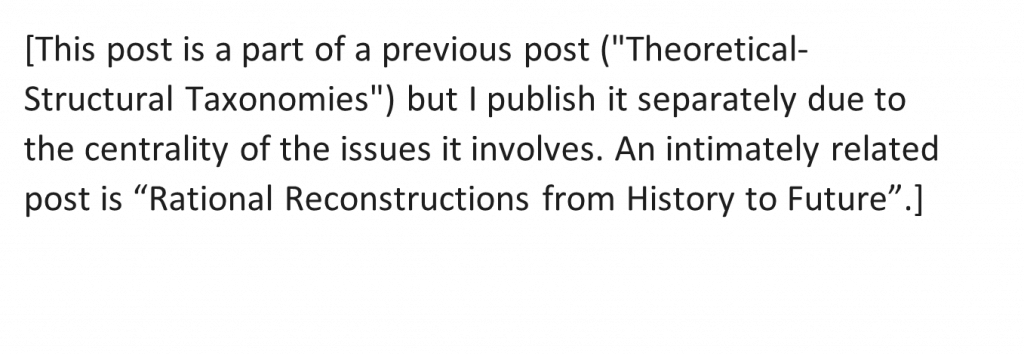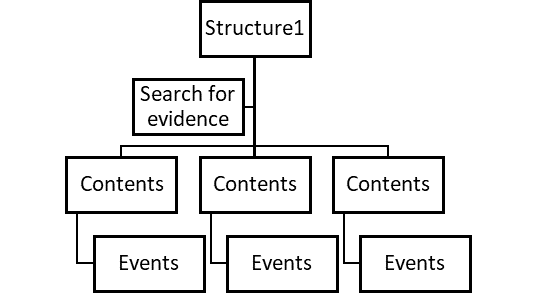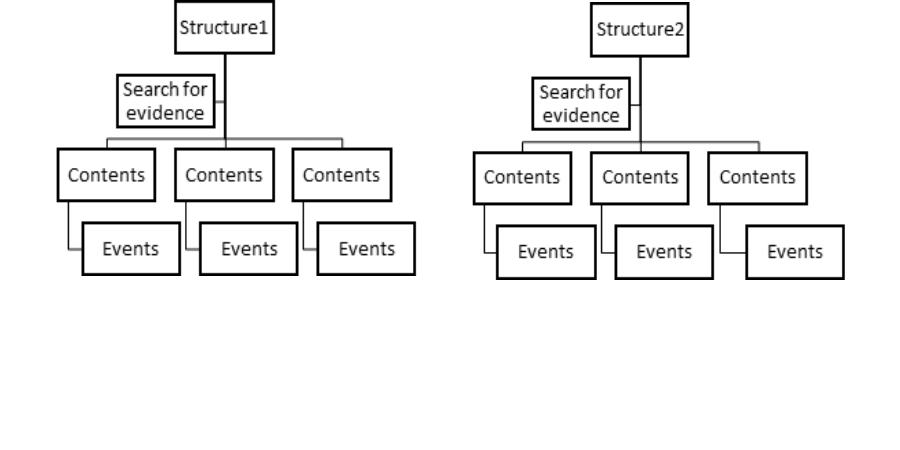
I suggest that theoretical knowledge is in the essence of understanding the possible structures of future within which more specific events take place. It is a nice coincidence that Kuhn named his famous book “The Structure of Scientific Revolutions” as this sense of structure is what I have mind in here. Let’s use Kuhn as an example as he is well known (I am not suggesting that he was right).
In the philosophy of science, there are many theoretical accounts of how science develops (focusing either on the whole or to some more specific question like theoretical continuity in science). One of them is Kuhn’s theory of paradigms, where science is dominated by a paradigm which defines the theoretical, methodological, conceptual, axiological and conceptual resources that the science has as well as the kinds of problems it attempts to solve. No paradigm lasts forever. Rather, each paradigm faces problems, anomalies, that it cannot solve, and once these become severe enough, a change in paradigm becomes possible. This change is a scientific revolution, and how that revolution will end is not determined by straightforward dynamics.
We could think that Kuhn’s theory defines a possible structure of future of science. If Kuhn is right, whatever the details, science will be dominated by a paradigm or there will be a revolution. In some cases, we might be able to determine the contest of a structure, i.e. to tell what that paradigm will be (in the case of revolution this is much more difficult if not impossible). For example, if a new particle accelerator is built, we might guess that it will shape the paradigm. Finally, there will be some events within the structure and its contents, but we are not interested in these per se. Individual events are too difficult to predict. However, we could be able to tell what kinds of events are possible within a structure and its contents. For example, we can estimate that if the new accelerator is built, certain types of experiments will happen.
Moreover, we can understand the search for evidence within this structural scheme. A structure, not evidence, is the starting point. Once we have decided what kind of structure our theoretical understanding allows, we can look for evidence for the contents of that structure. So we have the following scheme:

Moreover, there does not exist a single possible structure. Rather, we have many theories of science that define their own structures. For example, structural realism often commits to the view that the mathematical structures of successful theories are preserved during scientific change. This view implies that no dramatical changes á la Kuhn will happen. Given the different structures, we can formulate taxonomies of possible futures:

Such taxonomies are useful because (I) their theoretical bases are transparent, (II) they allow us to see at a glance what kind of futures are possible, and (III) they show whether some scenario is possible within many structures.
I cannot go to details of the epistemology of such taxonomies in this post. However, we can note that the credibility of an individual structure depends on the credibility of its theoretical basis. While these bases are difficult evaluate (in the philosophy of science, this is known as the problems of testing philosophical theories), considerations of historical relevance, coherence, simplicity, and explanatory power are relevant. It is also better to rely on transparent theoretical basis than to some mystical “contextual insights” or what have you.
We could also add some normative considerations. We might ask which of the potential theoretical basis shows science in a favorable light. We could then formulate a future structure by using that basis. These structures would describe desirable futures.
Moreover, we can evaluate the usefulness of individual structures in scenario-work on the basis of (i) how easy it is to collect evidence for individual contents within the structure, (ii) the number of possible contents (too many are difficult to manage), and (iii) the consequences of different contents on our ability to act (too pessimistic or optimistic are to be avoided). While these practical criteria may leave outside real future possibilities, they still enable us to direct our limited resources to understanding futures that we might achieve (or avoid).
Finally, it must be pointed out that these taxonomies tie together historiography and future. First, the philosophical theories of science are often based on historical considerations. Understanding history is necessary to create and evaluate possible structures. Secondly, both (i) historical understanding and (ii) scenario-work are based on understanding what could have been the case and structural considerations are necessary in achieving this understanding.
Counterfactuals
After pointing out that our evidence of the future is more difficult to find than evidence of the past, Staley takes a step to the right direction. “If we are to think seriously about the future, we must ‘fill in’ the missing information to the best of our ability. [–] To resolve this issue, it might be instructive to consider the parallels between histories of the future and counterfactual histories. [–] In both cases, the historian must make an inference about events and situations that have not occurred.” (p. 63). Now the idea is that if we are able to think rigorously about historical counterfactuals, we are also able to think rigorously about the future. I agree. However, the short answer for what makes a counterfactual scenario plausible that Staley gives, i.e. “We should consider as plausible or probable only those alternatives which we can show on the basis of contemporary evidence that contemporaries actually considered” does not work, as I have explained in detail elsewhere (see this post). We have to do better, and the structural approach above helps us.
Historical counterfactual provides us with information of the form “Alternative Y rather than actual X would have happened, had W rather than (actual) Z happened”. For example, we can say that “Scientists would not have believed in atoms, had Einstein not explained the Brownian motion”. In order to establish such claim, we need to
1. Consider evidence of the actual world. We need to find “causal clues” of the possible process from Z to X. For example, we could find a diary or letter where a scientist describes how Einstein’s work impacted her believes. Such evidence is not always found and is never conclusive. For example, I could write in a diary that I voted in an election because one of the candidates was so impressive. However, I might have voted in any case, even in the absence of the impressive candidate, because I like the voting booth. We need to establish the dependence of X on Z. However, actual evidence can provide us with candidates for Z.
2. Consider principles and regularities that describe the phenomena under interest. These might come from social or natural sciences or from other considerations (here we might rely on expert judgement is nothing else is left). For example, we might reason that Einstein’s work does explain the change in beliefs because we know that, in general, scientists are good in reflecting their own system of beliefs (assume this for the sake of the illustration) and a diary describing the cause of the change of belief is therefore sufficient to establish the impact. In some cases, we might question the dependency. For example, we might know that I watched many political debates and that people who follow these debates are very likely to vote. Therefore, the reasoning continues, the impressive candidate did not (probably) affect my voting; had the candidate been absent, I would still have voted. In these cases, the plausibility of the counterfactual depends on the plausibility of the underlying principles.
3. Consider theoretical structures that are purported to explain the phenomena. For example, we could rely on philosophical investigations on the importance of explanatory relevance in science to reason that it was Einstein’s explanation of the Brownian motion that was relevant in the change of beliefs. Someone else (sociologically oriented) could argue that it was the fact that Einstein explained (and not the explanation itself) that made a difference to the beliefs.
Such “philosophical” theories are difficult to compare with respect to their adequacy. Of course, there are considerations that are relevant in establishing the merits of different theories (theoretical progress is possible) but conclusive results are difficult to achieve. Therefore, historical counterfactual cannot be established with certainty. However, it does not follow that they are futile. Our knowledge is always fallible, but it does not follow that it is therefore futile. Moreover, the steps 1 and 2 above are able to limit the number of philosophical considerations that are relevant in counterfactual reasoning. Actual evidence matters. We do not drown in an endless see of philosophical pondering. Rather, we can debate the philosophical questions that remain once we have narrowed down the relevant consideration in each case. (See my 2018 paper.)
We see that historical counterfactuals can be assessed only in the light of theoretical structures. If we approach possible futures with the help of structural taxonomies, the possible futures can be analyzed in the same way as historical counterfactuals. While evidence of possible futures is more difficult to come by than evidence of the past and therefore the narrowing down of relevant considerations in deciding the most plausible futures is more difficult that in the case of history, the taxonomies enable us to see what kind of evidence could be helpful and what the space of possibilities looks like.
2 thoughts on “Theoretical Structures in the Estimating the Futures of Science”